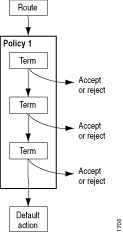How a Routing Policy Is Evaluated
Figure 1 shows how a single routing policy is evaluated. This routing policy consists of multiple terms. Each term consists of match conditions and actions to apply to matching routes. Each route is evaluated against the policy as follows:
-
The route is evaluated against the first term. If it matches, the specified action is taken. If the action is to accept or reject the route, that action is taken and the evaluation of the route ends. If the next term action is specified, if no action is specified, or if the route does not match, the evaluation continues as described in Step 2. If the next policy action is specified, any accept or reject action specified in this term is skipped, all remaining terms in this policy are skipped, all other actions are taken, and the evaluation continues as described in Step 3.
-
The route is evaluated against the second term. If it matches, the specified action is taken. If the action is to accept or reject the route, that action is taken and the evaluation of the route ends. If the next term action is specified, if no action is specified, or if the route does not match, the evaluation continues in a similar manner against the last term. If the next policy action is specified, any accept or reject action specified in this term is skipped, all remaining terms in this policy are skipped, all other actions are taken, and the evaluation continues as described in Step 3.
-
If the route matches no terms in the routing policy or the next policy action is specified, the accept or reject action specified by the default policy is taken. For more information about the default routing policies, see Default Routing Policies.

Each term can consist of two statements, from and to,
that define match conditions:
In the from statement, you define the criteria that an incoming route
must match. You can specify one or more match conditions. If you specify more than one,
all conditions must match the route for a match to occur.
In the to statement, you define the criteria that an outgoing route
must match. You can specify one or more match conditions. If you specify more than one,
all conditions must match the route for a match to occur.
The order of match conditions in a term is not important, because a route must match all match conditions in a term for an action to be taken.
